Things You'll Need
18-inch long, flat section of leaf spring
Metal-cutting bandsaw or hacksaw
Bench grinder
Belt sander
Drill with metal-boring bit
Metal files
Parachute cord
Epoxy glue
Whetstone or disc-array knife sharpeners
Optional: Black electrical tape
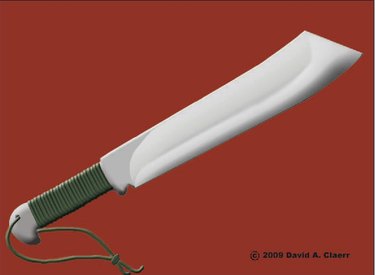
In the movie "Rambo IV," the title character loses his trusty high-tech blade and must quickly craft a survival knife from the materials at hand. He finds an old leaf spring from a vehicle and forges a somewhat crude but effective oversized blade, well-suited for jungle use. One way to craft an 18-inch Rambo-style knife from a leaf spring is using the stock-reduction method.
Step 1
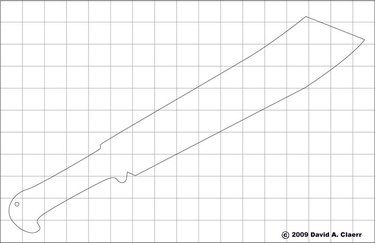
Print out the template plan for the pattern of the Knife blank. (Clicking on the small thumbnail will give you an enlarged image in a separate window.) The grid in the background represents 1-inch squares. Use the grid as a reference to scale up the drawing, or, if possible, print out the plan on an 11 by 17-inch ledger-size paper for a full-scale plan.
Video of the Day
Step 2
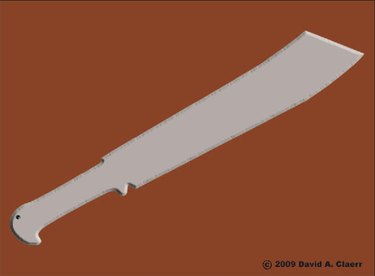
Cut out the pattern of the knife and trace the shape onto the section of leaf spring. Use the metal cutting saw to cut out the shape of the knife. The knife and handle are one continuous piece. After cutting out the shape, use the bench grinder and/or metal files to refine the edges. Drill out the small hole in the hilt to attach a wrist lanyard.
Step 3
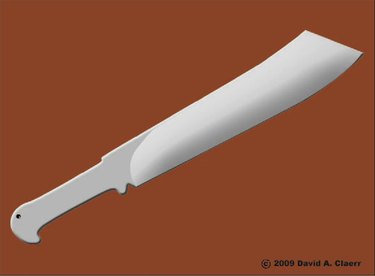
Make the first bevel for the blade using the bench grinder to remove metal to form a 40-degree angle from the cutting edge of the blade up to the back of the blade. Alternate grinding on either side of the blade to ensure that you are symmetrically grinding each side to the same amount of thickness. Refer to the image provided with this step for the area of the blade that is beveled.
Step 4
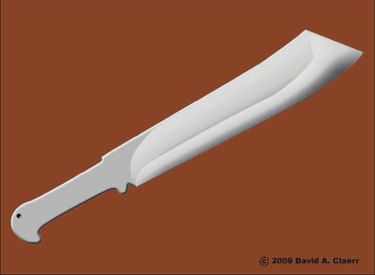
Make the second bevel to refine the cutting edge, using the belt sander and/or metal files to create a 32-degree angle bevel. Alternate grinding on either side of the blade to ensure that you are symmetrically grinding each side to the same amount of thickness. Refer to the image provided with this step for the area of the blade that is beveled.
Step 5
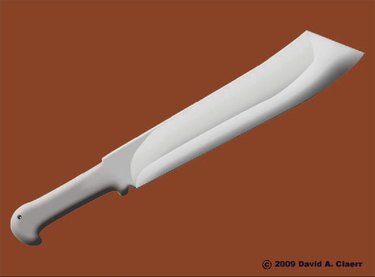
Grind a rounded bevel to the handle, starting with the bench grinder and finishing smooth with the belt sander or metal files. At this stage, you have the option to polish the blade and handle if you wish, although the Rambo knife was left in a roughly forged and ground state, with only the edge honed to sharpness.
Step 6
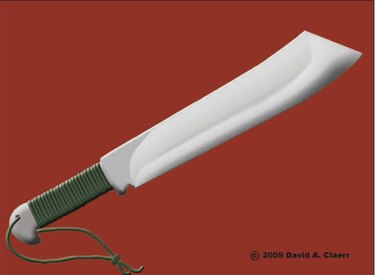
Apply a drop of epoxy to the handle, 1/4 inch inside of the area to be wrapped, to tack one end of the parachute cord down. Then begin wrapping the handle in a spiral, wrapping over the end you just tacked down. Apply the epoxy gradually in thin, short strips just ahead of each wrap. This method ensures that the epoxy does not set up too soon before the cord is wrapped over it. When the handle is wrapped to the end, trim the excess cord to a 1/4 inch on the end, and insert the end under the last two wraps of the cord. As a further option, the parachute cord wrap can be covered over with black electrical tape if you wish to replicate the handle of knife that Rambo made in the movie. Thread a 10-inch section of parachute cord through the hole in the handle's end and tie it off in a loop to form a wrist lanyard. Finish your knife by honing the edge with a whetstone or disc-array knife sharpener.
Tip
If your section of leaf spring is not flat enough, it may be necessarty to heat it in a forge to a bright red-orange and pound it flat with a smith's hammer on an anvil. Many metalworking shops will perform this service for you.
Warning
Use proper safety precautions using shop tools and machinery. Always wear protective safety gear, including safety goggles or glasses, heavy workman's gloves and shop aprons. Work only in well-ventilated areas. The project should only be attempted by mature adults who are experienced in using the tools and machinery recommended in this article.
Video of the Day